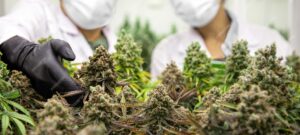Blog
Harvesting Cannabis: Timing is Everything
Cannabis cultivation is an art, and one of the most critical aspects of this process is knowing when to harvest your precious plants. Harvesting at the right moment can significantly impact the quality, potency, and overall experience of your cannabis crop. In this blog post, we’ll explore the crucial factors to consider and the telltale signs that indicate when your cannabis is ready for harvest.
1. Flowering Stage: The Beginning of the Countdown
The countdown to harvest begins when your cannabis plants enter the flowering stage. This stage is marked by the development of buds and trichomes, the tiny, resinous glands that contain the cannabinoids and terpenes responsible for the plant’s effects and aroma.
It’s essential to know the expected flowering time for your specific cannabis strain, as this can vary significantly. Typically, cannabis strains have a flowering period of 7 to 10 weeks. Keep track of when flowering starts so you can calculate the approximate harvest time.

2. Trichome Examination: The Key to Precision
One of the most accurate methods for determining when to harvest cannabis is by examining the trichomes with a magnifying glass or a jeweler’s loupe. Trichomes change color as they mature, which is an excellent indicator of harvest readiness. There are three stages to watch for:
- Clear trichomes: Early in the flowering stage, trichomes are mostly clear. At this point, the plant’s effects tend to be less potent.
- Cloudy trichomes: As the plant matures, the trichomes become cloudy or milky in appearance. This is often the best time to harvest if you prefer a balanced high with both head and body effects.
- Amber trichomes: When the trichomes turn amber, the plant is at its peak in terms of THC content and tends to provide a more relaxed, sedative high. This is preferred by some for a more calming experience.
The ideal harvest time depends on your personal preference and the effects you desire. Harvesting with mostly cloudy trichomes is a safe bet for a balanced experience.
3. Observing Pistils: A Visual Cue
Pistils are the hair-like structures on the flowers of the female cannabis plant. Initially, they are white, but as the plant matures, they change color. The color of the pistils can also be a helpful indicator:
- White pistils: At the beginning of the flowering stage, the pistils are white and straight. Harvesting at this stage will produce a more cerebral, energetic high.
- Changing pistils: As the plant matures, pistils often change color. They can turn orange, red, or brown. Harvesting during this phase will yield a more balanced high.

4. Nutrient Flushing: Enhancing Flavor and Smoothness
In the weeks leading up to harvest, many growers choose to flush their cannabis plants. This process involves using pure water to flush out excess nutrients from the soil. Flushing can improve the flavor and smoothness of your cannabis buds, as it reduces the presence of residual nutrients.
5. Environmental Conditions: Don’t Ignore the Basics
Apart from examining trichomes and pistils, environmental conditions play a role in determining the right time to harvest cannabis. Be mindful of the following factors:
- Humidity: Lower humidity during the last weeks of flowering can prevent mold and mildew.
- Light: Reducing light exposure during the last days of flowering can help preserve trichome quality.
- Temperature: Maintain an optimal temperature range, as extreme heat or cold can affect the quality of your cannabis buds.
6. The Harvest Window: A Short Timeframe
Once your cannabis plants reach their ideal state, be prepared to harvest within a relatively short timeframe. The trichomes’ maturity can change rapidly, and you don’t want to miss the peak harvest window.

Final Thoughts
Harvesting cannabis is a pivotal moment in the cultivation process. By paying close attention to trichome development, pistil color, and environmental conditions, you can ensure that your cannabis crop is harvested at the optimal time for the desired effects and quality. Remember, each strain may have unique characteristics, so observing and adapting to the specific needs of your plants is crucial. Happy harvesting!

